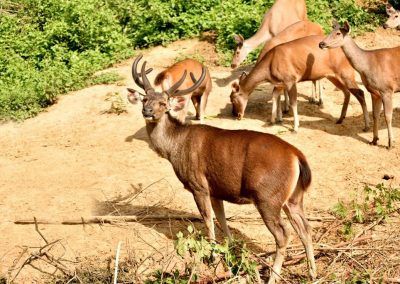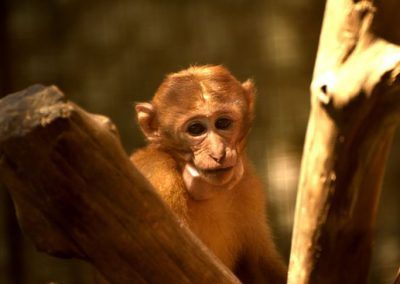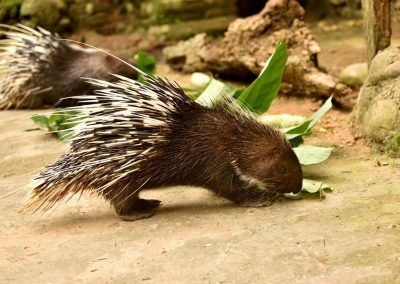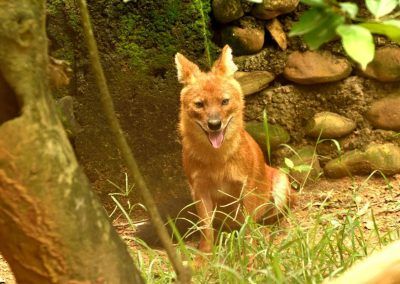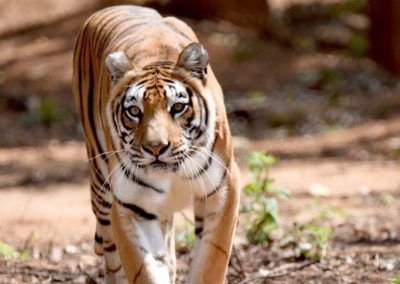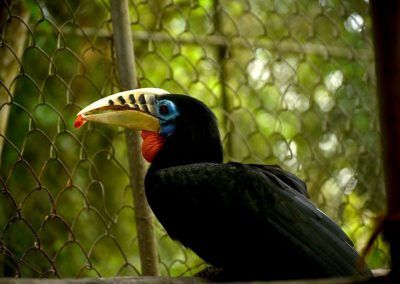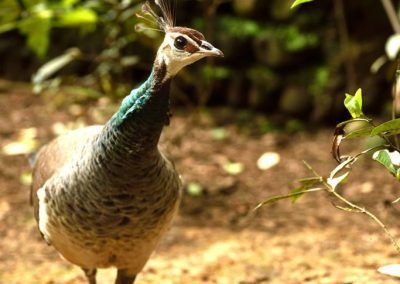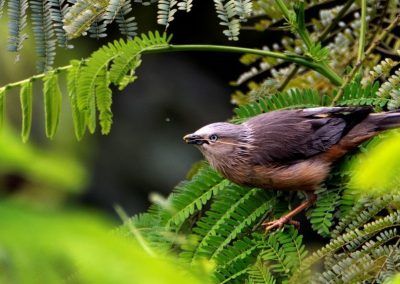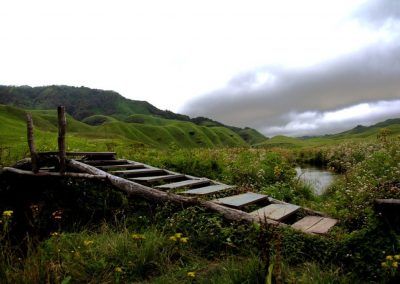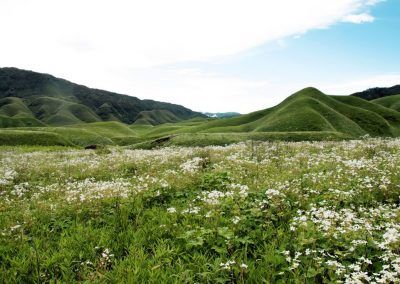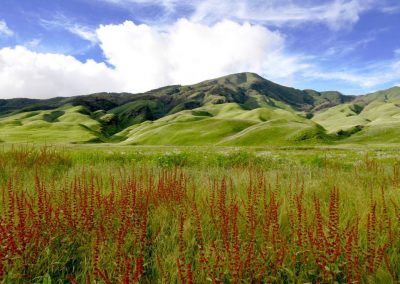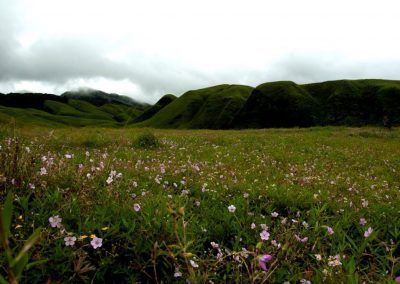Nagaland lies in the 10th distinct bio-geographic zone under one of the identified 18 Mega hot spot in the world with reference to threats to biodiversity. It has the finest Tropical, Subtropical Evergreen forests and a unique Broad leaved Moist Temperate forests. The floral vegetation and fauna elements represents the transition zone of Indian, Indo Malayan and Indo Chinese bio-geographic region. Many ancient angiosperms & primitive flowering plants are present and the area is considered as a cradle of flowering plants. It is also the Center of origin of some rice variety and secondary origin of citrus, chilly and maize etc.
| Sl.No. | Floristic diversity components | Sp. numbers. |
| 1 | Total crops Cultivated crops of Jhum fields |
231 105 |
| 2 | Wild edible fruits | 248 |
| 3 | Wild edible vegetables | More than 128 |
| 4 | Wilde edible flowers | 52 |
| 5 | Wild edible mushrooms | 58 |
| 6 | Domesticated fruits | More than 26 |
| 7 | Edible roots and tubers | 42 |
| 8 | Edible seeds and nuts | 54 |
| 9 | Medicinal plants | More than 656 |
| 10 | Bamboo species | 57 |
| 11 | Orchid sp. species | More than 345 |
| 12 | Cane species | 7 |
| 13 | Lichens | 346 |
| 14 | Ferns | 280 |
| 15 | Lesser known Indigenous spices | More than 46 |
| 16 | Indigenous local useful trees sp. | 560 |
| 17 | Commercial timber plants | 147 |
| Sl. No. | Faunal diversity components | Documented spp. numbers. |
| 1 | Animals & butterflies | 183 |
| 1 | Mammals | 67 |
| 2 | Aves | 541 + |
| 3 | Amphibian | 32 |
| 4 | Fish | 149 |
| 5 | Snake | 35 + |
| 6 | Lizard and geckos | 6 + |
| 7 | Mollusc (Snail) | 50 |
| 8 | Eatable insects | 78 |
THE ENDANGERED SPECIES- BOTH FLORA AND FAUNA IN NAGALAND AND MEASURES TAKEN BY THE GOVERNMENT TO PROTECT THEM AND PREVENT EXTINCTION.
The local population are beingintricately involved with the forests for their sustenance, be it agriculture, timber, small timber, day to day use items, medicinal plants, etc. These forest products are also their main source of income. Therefore, when the mainstay of the people is dependent on forest, destruction of forests is imminent and thereby endangering many valuable species. Due to the primitive method/ practice of cultivation (i.e. slash burning) the rich Biodiversity of the state is dwindling year by year. Most of species, both flora and fauna, appear to be endangered due to heavy biotic pressure/ interference and reckless deforestation. Their details are as follows.
FLORA
Dipterocarpousmacrocarpous (Hollong), Shoreaassamica (Makai) ,Rodhodendron Spp. , Mesuaferra (Nahar), are rare and endangered spp. Panaxgensing (Gensing) is found only in Tuensang district at higher altitude. It is endangered. Aquilariaagallocha (Agar)is also an endangered species. Rare and Endangered species of Orchids available in Nagaland are as follows, Thunia 1 spp, Arundinariagraminifolia (Bamboo orchid), Renenthera (Red vanda), ,Rhynchostylis (fox tail), Pleoni, Phauis (ground orchid) 2 spp, Paphiopedilum 1 spp, Cymbidium tigrinum 1 spp. The Govt. is taking measures for propagation of conservation and protection of these spp. through different afforestation schemes.
FAUNA
The largest Asian mammal, Elephant is endangered spp. The other endangered spps are Melursesursinus (Sloth Bear), Prionodonpardicolor (Spotted linsang, Tiger-civet), Pantheratigris (Tiger),Macacaassamensis (Tailed Pig). The Gaur, or Indian Bison in habitats in Intangki National Park and Fakim Wildlife Sanctuary and other hilly areas is facing extinction from Nagaland The different Horn bills and Tortoise are also endangered.
COMMUNITY CONSERVATION IN NAGALAND
The conservation of common pool resources by local communities has a long history in Nagaland. Such conservation initiatives have been traditionally practiced in different forms with varied institutional structures. Several such practices are initiated by community organization like youth organization, women groups, religious/cultural groups and village councils with the community as a spontaneous reaction to address the problems of forest/environment degradation. Nagaland has 407 documented Community Conserved Areas (CCAs) out of which 343 Nos of CCAs, which constitute 84.3% are self initiated and 62 Nos of CCAs (15.2%) are being initiated by Forest Department.
| Sl. No. | Name of District | Self-initiated | CCA initiated by | Total No. of CCA |
| Forest Department | ||||
| 1 | Kohima | 12 | 2 | 15 |
| 2 | Phek | 52 | 13 | 66 |
| 3 | Zunheboto | 31 | 0 | 31 |
| 4 | Mokockchung | 41 | 12 | 53 |
| 5 | Kiphire | 34 | 0 | 34 |
| 6 | Longleng | 4 | 0 | 4 |
| 7 | Tuensang | 44 | 4 | 48 |
| 8 | Peren | 51 | 22 | 74 |
| 9 | Dimapur | 2 | 2 | 4 |
| 10 | Mon | 64 | 5 | 69 |
| 11 | Wokha | 7 | 2 | 9 |
| Total | 343 | 62 | 407 |
Source: Documentation of community conserved Areas of Nagaland
(TERI, Delhi & Forest Department)

